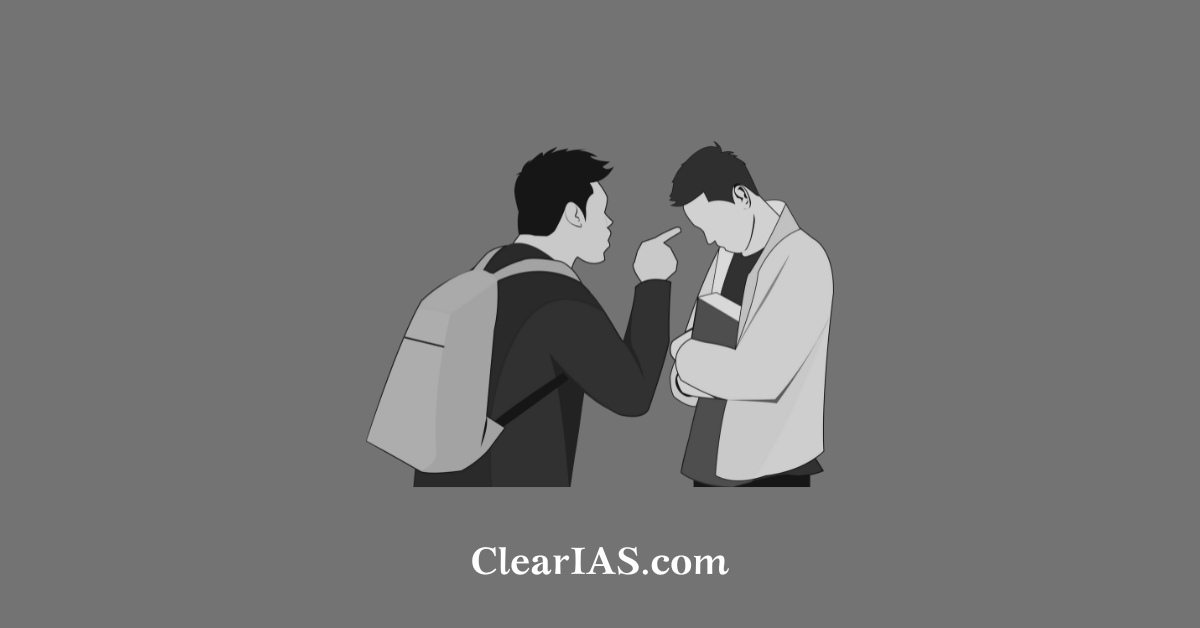
Read further to know more.
What is ragging?
Ragging is defined as an act that violates or is perceived to violate an individual student’s dignity. Done in pretext of ‘welcoming’ the fresher, ragging is an emblem of how far the pervasive human imagination can extent. True, human imagination knows no bounds, so does the diabolic Ragging acts.
Psyche behind Ragging
- Sense of Authority: By having the freshmen always at his command, a senior student nurtures a sense of authority which boasts his morale and puts him on a high.
- Means of Retaliation: A senior who has some previous history of ragging may like to get back by venting his frustrations on the
- Sadistic Pleasures: A potential ragger sees ragging as a good opportunity to satiate his sadistic pleasures all at the cost of a poor freshmen’s imagination.
- Peer Pressure: It is also a reality that not all seniors who commit ragging enjoy doing it at their sweet will. Seeing most of their batch mates indulging in ragging, they fear being left out. So in order to avoid isolation, they too join the herd.
- Tangible benefits: in the form of money, new dress, rides etc.
- Fashion Statement: Many senior students live under the misconception that ragging makes a style statement and thus will put them in the ‘influential crowd’ of their college.
Role of different stake-holders to prevent ragging

To create a Ragging free environment and prevent grievous physical injuries and fear psychosis, it requires a concerted action from all stakeholders. Some of their roles are:
Governments:
A strong anti-Ragging legislations with firm yet reformative punishment system is a duty of both Central and State governments. Following Supreme Court judgement in Aman Kachroo death, the government operates toll-free number of 1800-180-5522 and e-mail complaint service [email protected]; which registers complaints of students while maintaining anonymity. The government in 2007 had set up Raghavan Committee to study on the Ragging issue; and many of its recommendations have been implemented in a phased manner. Further, the government can use NGOs, print media, TV, radio etc. to spread awareness among the students. On a wider canvas, the government must rein in on use of alcohol and addictive drugs in the campus, which feeds into Ragging incidents.
Judiciary:
So far there have been two landmark judgments prohibiting ragging. These are:
- Ragging of Freshers in Thiruvananthapuram Government Engineering College vs. State of Kerala.
- Vishwa Jagriti Mission through President vs. Central Government through Cabinet Secretary.
Regulatory Bodies:
The UGC as well as sectoral bodies like AICTE, MCI etc. needs to send in timely reminders about role of institutions in curbing the menace and ways and means to do the same. The fact that the UGC guidelines of 2009 remains the only comprehensive anti-Ragging policy in India cements this thought. Further, NCERT & SCERTs can include a chapter on Ragging, in school textbooks so that the children are moulded in budding stage itself
College Authorities:
With roles on both prevention and affirmative action on default, college authorities are the most effective cog in anti-Ragging mechanism. Proactive monitoring can be done by forming teachers’ collegium who undertake surprise visits and anonymous surveys. Authorities are also bound to set up anti-Ragging cells at the college, which can offer counselling and human rights lessons. College can organise interactive sessions between senior and junior students to build a rapport. Adverse spots mapping, staggered entry of fresher and seniors, setting up Drop Boxes, awareness classes etc. are novel ways to reduce adversities. Teachers need to have personal rapport with students to understand their problem.
Parents:
Parents need to look for signs like refusing to talk, injuries, crying spells etc. They can liaise their action with class teacher or college authorities or in extreme cases with the police.
Senior students:
Besides human conscience, the senior students are also bound by an undertaking, which they sign up on admission, to refrain from Ragging. The students union and other bodies can also form anti-Ragging squads to persuade their peers to keep away from Ragging and make them aware of the Anti-Ragging laws.
Fresher:
They must be aware of what constitutes ragging and also about their rights. Knowledge about anti-Ragging cells, helpline numbers, counselling centres etc. is mandatory and they mustn’t hesitate use them, if need arises. Further they can use RTI methods to get parents’ contact number of the seniors ragging them, and ask them to intervene on their behalf.
Civil Society
NGOs like CURE, SAVE, Aman Movement etc. must be made part of anti-Ragging mechanism of the college and allowed to use their niche knowledge to curb the malice.
Article by: Jishnu J Raju






This app is awosome, I need previous papers exam
of preliams&mains
Great to hear that you are one of the happy users of our app. Link for previous year papers are given in the footer links of this website. You have also the option to re-attempt the previous paper in a timed atmosphere in our mock test platform. Check cleariasexam.com.
will u please suggest me that how could i cover all the chapters of upsc exam
I’ve been following clearias for quite a while now. I must say, its a pleasure to go through the concepts, which are covered in depth.
I’m a first year Geology student, and will most likely appear for UPSC Civil Services after graduation. I would like to know whether I should take up Geology as my optional subject or any other related subject?